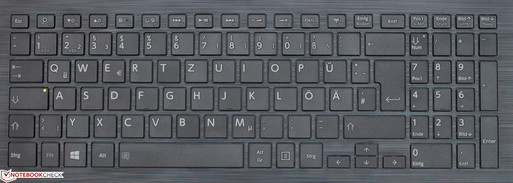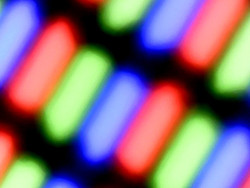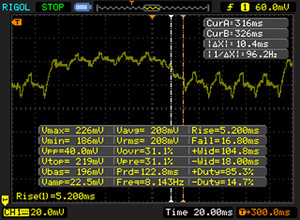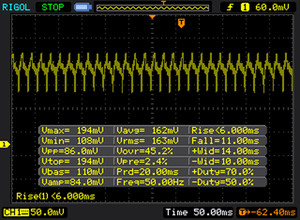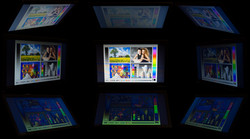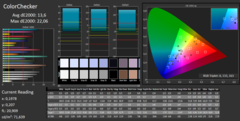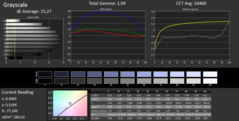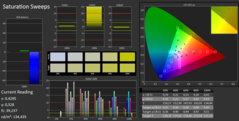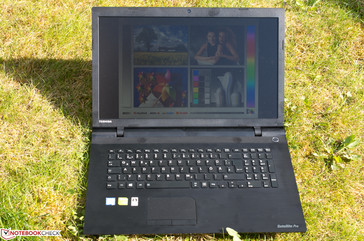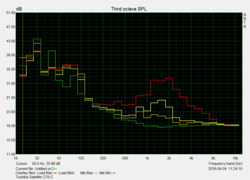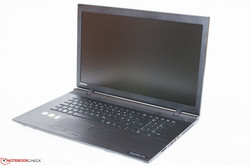Toshiba Satellite C70-C-1FT Notebook Review

For the original German review, see here.
The Toshiba C70-C-1FT is yet another multimedia notebook designed mostly for stationary use. The included hardware is pretty common right now and can be found in many different notebooks in various segments of the market. One of these frequently-seen items is the Intel Core i5-6200U, which did very well in a number of our reviews. The GPU is the gaming-capable Nvidia GeForce 930M. The 17-inch class is hotly contested, however, so there are plenty of alternatives:
| Model | Dell Inspiron 17 5759-5118 | HP Pavilion 17-f217ng | Asus N552VX-FY103T | Acer Aspire V Nitro BE VN7-792G-74Q4 |
| Size | 17.3-inch | 17.3-inch | 15.6-inch | 17.3-inch |
| Resolution | 1920 x 1080 | 1600 x 900 | 1920 x 1080 | 1920 x 1080 |
| CPU | Intel Core i5-6200U | Intel Core i5-5200U | Intel Core i7-6700HQ | Intel Core i7-6700HQ |
| GPU | AMD Radeon R5 M335 | Nvidia GeFoce 830M | Nvidia GeForce GTX 950M | Nvidia GeForce GTX 960M |
Case & Connectivity
The design looks rather ordinary. The upper part of the base unit is made from plastic with a brushed texture. The bottom and the top of the lid are smooth. The chassis could be a little more sturdy: picking the unit up with one hand, for example, left us with an uneasy feeling regarding the overall stability. Rubber feet make sure that the notebook remains put even on very slick surfaces. The display hinges bounce a lot. The areas below and next to the keyboard yield easily when pressure is applied. Although noticeable while typing, it does not have a detrimental effect. Fingerprints are an issue and tend to show up after a very short time.
The transition gaps between the parts are rather large and accumulate dust somewhat easily. The chassis can be opened without a problem even though there are no maintenance covers. Expansion is limited to a second RAM slot. The battery can be swapped out easily once two screws are removed.
To measure the performance of the SD card reader, we use a Toshiba Exceria Pro SDXC 64 GB UHS-II reference card. We recorded 84.3 MB/s for large data blocks and about 35 MB/s for JPGs (5 MB each). These transfer rates aren't very impressive.
Input Devices
Keyboard
The keyboard isn't one of the Toshiba's strengths. Even though the feedback is decent and far from spongy, the key travel is particularly short. Once actuated, the keystroke ends rather abruptly, which is a little uncomfortable at first. The keys themselves are not rounded and their surfaces don't conform to the fingers. A backlight is lacking, but the function keys have additional mulitmedia functions, which makes them - just like the dedicated number block - quite useful.
Touchpad
The touchpad surface lets fingers glide easily, but lacks precision. This is not a clickpad, which means the user has to click the dedicated mouse buttons or double-tab on the pad itself. With a size of 9 x 5.4 cm the touchpad is rather small as well - given this is a 17-inch notebook, Toshiba could've easily made it larger. The lower and the right edge support horizontal and vertical scrolling, but gestures sometimes activate scrolling by accident. Multitouch works as intended, although switching between the two input styles frequently leads to misinterpretations.
Display
The Toshiba is equipped with a matte display panel with a native resolution of 1600 x 900 pixels. The maximum brightness of 266 cd/m² is below average and the contrast of only 263:1 downright mediocre. Given that the notebook sells for about 900 Euro (~$1025), these results are not exactly appealing. In addition, the display exhibits PWM flickering at a brightness of below 90 % at a very low frequency of only 50 Hz, which can lead to eye strain or headaches even for those who are not particularly susceptible.
| |||||||||||||||||||||||||
Brightness Distribution: 86 %
Center on Battery: 266 cd/m²
Contrast: 263:1 (Black: 1 cd/m²)
ΔE ColorChecker Calman: 13.6 | ∀{0.5-29.43 Ø4.83}
ΔE Greyscale Calman: 15.27 | ∀{0.09-98 Ø5.1}
71% sRGB (Argyll 1.6.3 3D)
46% AdobeRGB 1998 (Argyll 1.6.3 3D)
52% AdobeRGB 1998 (Argyll 3D)
70.9% sRGB (Argyll 3D)
52.4% Display P3 (Argyll 3D)
Gamma: 1.94
CCT: 16460 K
Display Response Times
| ↔ Response Time Black to White | ||
|---|---|---|
| 10 ms ... rise ↗ and fall ↘ combined | ↗ 5 ms rise | |
| ↘ 5 ms fall | ||
| The screen shows good response rates in our tests, but may be too slow for competitive gamers. In comparison, all tested devices range from 0.1 (minimum) to 240 (maximum) ms. » 25 % of all devices are better. This means that the measured response time is better than the average of all tested devices (20.5 ms). | ||
| ↔ Response Time 50% Grey to 80% Grey | ||
| 17 ms ... rise ↗ and fall ↘ combined | ↗ 7 ms rise | |
| ↘ 10 ms fall | ||
| The screen shows good response rates in our tests, but may be too slow for competitive gamers. In comparison, all tested devices range from 0.165 (minimum) to 636 (maximum) ms. » 29 % of all devices are better. This means that the measured response time is better than the average of all tested devices (32.1 ms). | ||
Screen Flickering / PWM (Pulse-Width Modulation)
| Screen flickering / PWM detected | 50 Hz | ≤ 90 % brightness setting | |
The display backlight flickers at 50 Hz (worst case, e.g., utilizing PWM) Flickering detected at a brightness setting of 90 % and below. There should be no flickering or PWM above this brightness setting. The frequency of 50 Hz is very low, so the flickering may cause eyestrain and headaches after extended use. In comparison: 53 % of all tested devices do not use PWM to dim the display. If PWM was detected, an average of 8327 (minimum: 5 - maximum: 343500) Hz was measured. | |||
The color accuracy leaves to be desired as well and the display suffers from a distinctly bluish hue. The average DeltaE color deviation is 13.6 with the maximum at 22.06. The goal here is a value of 3 or lower. Colors with values above this threshold deviate clearly from what they should look like. For a bargain-priced notebook this wouldn't be such a big deal, but considering the price of the review notebook, this lack of performance isn't really acceptable in our book. All competitors except for the much lower-priced HP Pavilion fare much better here.
The viewing angle stability is acceptable - at least in the horizontal plane. Deviations in the vertical plane lead to very noticeable color shifts.
Performance
The Toshiba Satellite C70-C-1FT is a 17.3-inch allrounder notebook predominantly designed for desktop use. The hardware is powerful enough to handle most standard workloads and light multi-tasking. At low resolutions, the notebook can handle gaming as well. At the time of writing, the Satellite sells for about 900 Euro (~$1025).
Processor
The notebook is equipped with an Intel Core i5-6200U. This frugal dual-core CPU offers middle-class performance and is thus more than sufficient to handle even multitasking without major issues. In addition to hyperthreading, the processor also has a very low TDP of only 15 watts. The i5-6200U is clocked at 2.3 GHz, although the Turbo can overclock one core to 2.8 GHz and both cores to 2.8 GHz. Full performance is available no matter if the notebook is plugged in or running on battery power.
Users requiring more power should take a look at the Asus N552VX-FY103T, which comes with the much more potent Intel Core i7-6700HQ. The notebook with its quad-core i7 CPU offers about double the performance in the Cinebench R15 CPU multi-core benchmark and scores about 20 % higher in the single-core test. The quad-core processor only really makes sense if the applications are designed to take advantage of it.
Less expensive options are the Dell Inspiron 17 5759-5118 (same processor) or the HP Pavilion 17-f217ng, which comes with the less powerful Intel Core i5-5200U, but still offers quite comparable performance.
System Performance
Thanks to its modern Intel Core i5 processor and a decent enough hard drive make, the notebook responds fairly quickly and smoothly. We didn't encounter any problems or issues during the review period. Although the results of the PCMark 8 benchmark trail the competition slightly, they are still decent. Other notebooks with similar hardware shouldn't be much faster or slower - at least not noticeably so. The more powerful notebooks pull ahead slightly, but during daily use this should be of little to no consequence.
| PCMark 8 - Home Score Accelerated v2 | |
| Acer Aspire V Nitro Black Edition VN7-792G-74Q4 | |
| Asus N552VX-FY103T | |
| Dell Inspiron 17 5759-5118 | |
| HP Pavilion 17-f217ng | |
| Toshiba Satellite C70-C-1FT | |
| PCMark 8 Home Score Accelerated v2 | 2906 points | |
Help | ||
Storage Devices
Toshiba integrated their own 2.5-inch HDD with a capacity of 1000 GB and a rotational speed of 5400 RPM. The benchmark results are decent for a drive in this class and the competing models don't offer appreciably better scores.
GPU Performance
Toshiba has equipped this particular Satellite with an Nvidia Geforce 930M. The GPU is based on the Maxwell architecture, supports DirectX 11, and offers a base core speed of 928 MHz and a maximum speed of 941 MHz. The graphics card has access to 2048 MB of DDR3 RAM running at 900 MHz. The frequencies mentioned are available even when the notebook is running on battery power.
In addition to the GeForce graphics card, the notebook also features the processor-integrated Intel HD Graphics 520. Nvidia's Optimus technology can switch between the GPUs, which in turn can extend the battery life.
As an alternative, the Asus N552VX-FY103T comes equipped with the GTX 950M, which offers about twice the performance. The HP Pavilion 17-f217ng ships with the predecessor of the 930M and scores only slightly lower. The Dell Inspiron 17 5759-5118 is equipped with a Radeon R5 M335, which is a noticeably weaker GPU.
| 3DMark 11 Performance | 2260 points | |
Help | ||
Gaming Performance
We shouldn't expect top-notch performance of course, but the notebook is definitely gaming-capable. The GPU can handle older titles even at high detail settings. Newer games or more demanding graphics settings are out of the question, however.
We used an external monitor to check the gaming performance at maximum details, since the Toshiba only supports a resolution of 1600 x 900 pixels.
Competing notebooks like the HP Pavilion 17-f217ng and the Dell Inspiron 17 5759-5118 trail our review notebook in this area as expected; the more powerful alternatives Asus N552VX-FY103T and the Acer Aspire V Nitro Black Edition VN7-792G-74Q4 both score higher. If gaming is frequently on the agenda, we recommend looking at a notebook with at least a Geforce GTX 960M or better.
| low | med. | high | ultra | |
|---|---|---|---|---|
| Tomb Raider (2013) | 122 | 60 | 33 | 16 |
| BioShock Infinite (2013) | 83.2 | 47.65 | 38.78 | 13.17 |
| BioShock Infinite | |
| 1366x768 Medium Preset | |
| Asus N552VX-FY103T | |
| Toshiba Satellite C70-C-1FT | |
| Dell Inspiron 17 5759-5118 | |
| 1366x768 High Preset | |
| Asus N552VX-FY103T | |
| Toshiba Satellite C70-C-1FT | |
| Dell Inspiron 17 5759-5118 | |
| Tomb Raider | |
| 1366x768 Normal Preset AA:FX AF:4x | |
| Acer Aspire V Nitro Black Edition VN7-792G-74Q4 | |
| Toshiba Satellite C70-C-1FT | |
| HP Pavilion 17-f217ng | |
| Dell Inspiron 17 5759-5118 | |
| 1366x768 High Preset AA:FX AF:8x | |
| Acer Aspire V Nitro Black Edition VN7-792G-74Q4 | |
| Toshiba Satellite C70-C-1FT | |
| HP Pavilion 17-f217ng | |
| Dell Inspiron 17 5759-5118 | |
Emissions & Energy
System Noise
The noise emissions are a particular strength, as the Toshiba never gets very loud and remains far from obtrusive. Even under load, the Satellite is noticeably less noisy then the competition: we measured around 35 dB, which is only slightly above the average result at idle. Only the optical drive could be a little less noisy in our opinion.
Noise Level
| Idle |
| 32.3 / 32.3 / 33.2 dB(A) |
| HDD |
| 33.1 dB(A) |
| DVD |
| 37.6 / dB(A) |
| Load |
| 34.9 / 40.3 dB(A) |
 | ||
30 dB silent 40 dB(A) audible 50 dB(A) loud |
||
min: | ||
| Toshiba Satellite C70-C-1FT GeForce 930M, 6200U, Toshiba MQ01ABD100 | Dell Inspiron 17 5759-5118 Radeon R5 M335, 6200U, Seagate Momentus SpinPoint M8 ST1000LM024 HN-M101MBB | HP Pavilion 17-f217ng GeForce 830M, 5200U, HGST Travelstar 5K1000 HTS541075A9E680 | Asus N552VX-FY103T GeForce GTX 950M, 6700HQ, Toshiba MQ02ABD100H | Acer Aspire V Nitro Black Edition VN7-792G-74Q4 GeForce GTX 960M, 6700HQ, Toshiba MQ02ABD100H | |
|---|---|---|---|---|---|
| Noise | -10% | -8% | -4% | -5% | |
| off / environment * | 31.2 | 31.3 -0% | |||
| Idle Minimum * | 32.3 | 33.9 -5% | 32.2 -0% | 33.1 -2% | 32.6 -1% |
| Idle Average * | 32.3 | 33.9 -5% | 32.2 -0% | 33.2 -3% | 32.6 -1% |
| Idle Maximum * | 33.2 | 33.9 -2% | 33.6 -1% | 33.2 -0% | 33.4 -1% |
| Load Average * | 34.9 | 43.8 -26% | 43.6 -25% | 37.7 -8% | 36.5 -5% |
| Load Maximum * | 40.3 | 44.2 -10% | 45.2 -12% | 43.4 -8% | 48 -19% |
* ... smaller is better
Temperature
The Toshiba handles our stress test (Prime95 and Furmark in parallel for at least one hour) in identical fashion no matter if it is plugged in or running on battery. We didn't encounter throttling at all. The Satellite does very well again as far as the temperatures are concerned: even under maximum load, the warmest areas are barely warm to the touch. Despite the low TDP of the CPU and the dedicated GPU, this is not something that can be taken for granted. The competition gets either about as warm as the review notebook or considerably hotter.
(+) The maximum temperature on the upper side is 37.4 °C / 99 F, compared to the average of 36.9 °C / 98 F, ranging from 21.1 to 71 °C for the class Multimedia.
(+) The bottom heats up to a maximum of 37.6 °C / 100 F, compared to the average of 39.2 °C / 103 F
(+) In idle usage, the average temperature for the upper side is 24.2 °C / 76 F, compared to the device average of 31.3 °C / 88 F.
(+) The palmrests and touchpad are cooler than skin temperature with a maximum of 31.1 °C / 88 F and are therefore cool to the touch.
(-) The average temperature of the palmrest area of similar devices was 28.7 °C / 83.7 F (-2.4 °C / -4.3 F).
Speakers
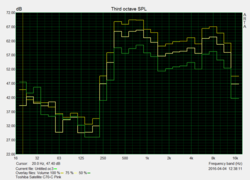
The sound quality of the upwards-firing speakers is acceptable. Bass is definitely lacking, but the mids and highs are decent. Although the speakers sound compressed and somewhat empty, even listening to music isn't an overly onerous task. The speakers do their job, but not much more. Of course the user can always hook up external speakers via the 3.5 mm audio jack.
Power Consumption
The Toshiba requires up to 14 watts during idle, which is slightly higher than the competitors with the same CPU. On average, the Satellite is less frugal than the more powerful competitors with quad-core CPUs.
The scenario under load isn't any different, as the Toshiba still maintains the top spot compared to similar models. Notebooks with quad-core CPUs draw even more power under load though and now pull ahead of the review notebook. The power adapter is rated at 65 watts and never is taxed to its limit.
| Off / Standby | |
| Idle | |
| Load |
|
Key:
min: | |
| Toshiba Satellite C70-C-1FT GeForce 930M, 6200U, Toshiba MQ01ABD100 | Dell Inspiron 17 5759-5118 Radeon R5 M335, 6200U, Seagate Momentus SpinPoint M8 ST1000LM024 HN-M101MBB | HP Pavilion 17-f217ng GeForce 830M, 5200U, HGST Travelstar 5K1000 HTS541075A9E680 | Asus N552VX-FY103T GeForce GTX 950M, 6700HQ, Toshiba MQ02ABD100H | Acer Aspire V Nitro Black Edition VN7-792G-74Q4 GeForce GTX 960M, 6700HQ, Toshiba MQ02ABD100H | |
|---|---|---|---|---|---|
| Power Consumption | 16% | 18% | -23% | -31% | |
| Idle Minimum * | 10.6 | 6.2 42% | 6.8 36% | 7 34% | 5.8 45% |
| Idle Average * | 13.5 | 11.6 14% | 11.8 13% | 10.9 19% | 9 33% |
| Idle Maximum * | 14 | 12.3 12% | 12.2 13% | 12.9 8% | 14.7 -5% |
| Load Average * | 44 | 36 18% | 37.8 14% | 72 -64% | 85 -93% |
| Load Maximum * | 52 | 55 -6% | 44.6 14% | 109 -110% | 121.5 -134% |
* ... smaller is better
Battery Life
Our WLAN test simulates a real-life scenario and loads a new web page every 40 seconds via a script. We activate the power-saving profile and set the display to a brightness of 150 cd/m². The Satellite shut down after 4 hours and 12 minutes, which is an average result, but pretty good for this class. Only the Dell Inspiron 17 lasted 50 minutes longer.
Pros
Cons
Verdict
The Toshiba Satellite leaves us with decidedly mixed feelings. In all secondary areas the notebook scores well: it never gets hot and is extremely quiet, which allows it to distance itself from the competition. It could be even more frugal, however.
In the areas where it counts the notebook doesn't do nearly as well - although at least the performance is not one of the affected areas. The input devices are far from impressive. The keyboard is good enough for occasional typists, but unfortunately nothing more. Users who need to type a lot are much better served with a different notebook. The touchpad takes some getting used to as well: since this is not a clickpad, the operation is somewhat unintuitive at times and feels like a significant step backwards. The most serious drawback is the quality of the display. Not only are the colors muddled and the contrast lacking, but the brightness control is implemented using PWM with a particularly low frequency, which will affect sensitive people and can cause headaches and nausea. The editor of this review was actually affected as well.
All things considered, the Toshiba Satellite C70-C-1FT looks decent enough on paper and produces mostly decent results, but unfortunately it simply fails in many important categories.
Other notebooks utilize PWM at much higher frequencies or not at all. All alternative notebooks we mentioned generally offer more for the money, so we'll list them one more time: Dell Inspiron 17 5759-5118 (17.3-inch), HP Pavilion 17-f217ng (17.3-inch), and Asus N552VX-FY103T (15.6-inch).
Toshiba Satellite C70-C-1FT
- 05/06/2016 v5.1 (old)
René Kohl











